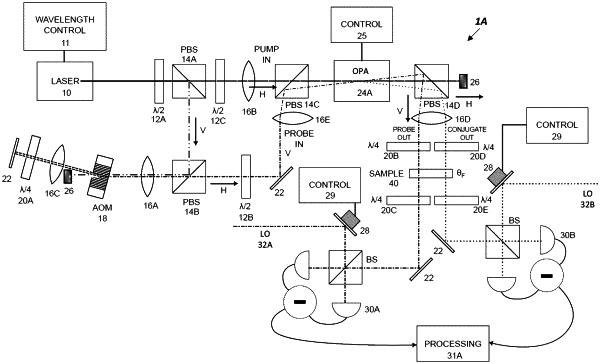| CPC G01N 21/31 (2013.01) [G01N 2201/06113 (2013.01); G01N 2201/0636 (2013.01); G01N 2201/10 (2013.01)] | 28 Claims |

|
1. A nonlinear interferometer system comprising:
a laser module configured to produce a source beam which is used to produce a pump beam of light having a first frequency f1;
a nonlinear medium positioned to receive at least the pump beam and issue the pump beam, a probe beam of light having a second frequency f2, and a conjugate beam of light having a third frequency f3 such that (f1−f2)=(f3−f1), wherein the nonlinear medium is configured to produce at least one of the probe light and the conjugate light based on interaction of the received light with the nonlinear medium, and wherein the issued beams are linearly polarized;
optics configured to route the probe beam along a first path to a sample or the conjugate beam along a second path to the sample or both the probe beam and the conjugate beam to the sample, wherein the sample imparts a Faraday polarization rotation or a Kerr polarization rotation to the light that interacts with the sample;
an optical transduction module configured to impart to the interacted light an optical phase shift that is a 1:1 transduction of the polarization rotation caused by the sample on the light which interacted with the sample, the optical transduction module being disposed in the first path or the second path or both the first path and the second path;
a first homodyne detection module configured to receive the probe beam at the end of the first path and output a first detection signal corresponding to the probe light, and a second homodyne detection module configured to receive the conjugate beam at the end of the second path and output a second detection signal corresponding to the conjugate light, wherein at least one of the probe light or the conjugate light carries the optical phase shift; and
a processor configured to obtain the optical phase shift based on the first detection signal and the second detection signal and determine, based on the obtained optical phase shift at least one of the Faraday polarization rotation, the Kerr polarization rotation or a spin noise spectrum.
|